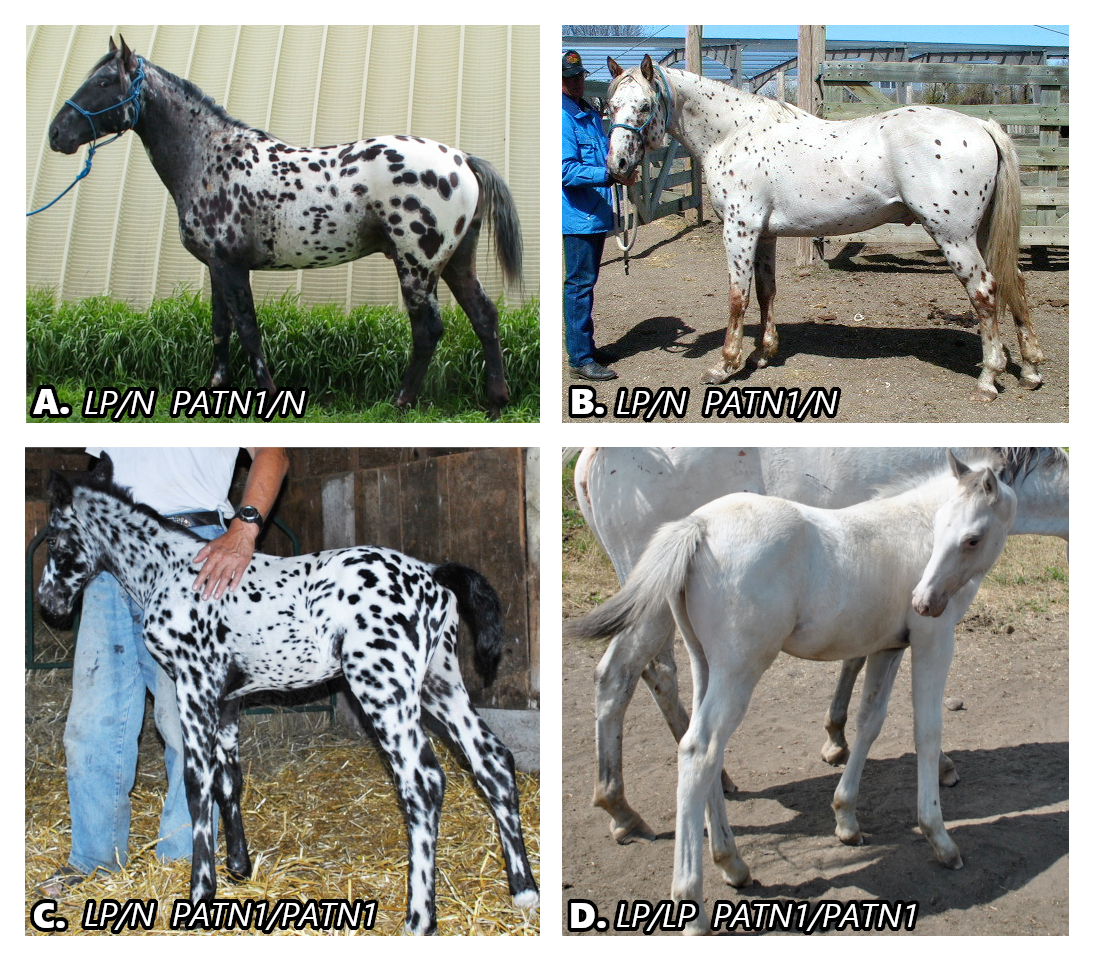Quick Summary
Click here for Price and Turnaround Time
Phenotype: Appaloosa Pattern-1 is a modifier of the leopard complex spotting (LP) and controls the amount white in the coat, increasing the amount of white present in horses that also have the LP mutation.
Mode of Inheritance: Autosomal dominant
Alleles: N = Normal, PATN1 = Pattern-1
Breeds appropriate for testing: Appaloosa, Appendix, British Spotted Pony, Australian Spotted Pony, Knabstrupper, Noriker, Miniature Horse, Pony of the Americas, among others
Explanation of Results:
- Horses with N/N genotype will not have increased amount of white in their coat related to PATN1 and cannot transmit an Appaloosa Pattern-1 variant to their offspring.
- Horses with N/PATN1 genotype that are also LP (N/LP or LP/LP) will have high amounts of white patterning (typically more than 60% at birth). They may transmit the Appaloosa Pattern-1 variant to 50% of their offspring.
- Horses with PATN1/PATN1 genotype that also have at least one copy of LP (N/LP or LP/LP) will have high amounts of white patterning. They will transmit an Appaloosa Pattern-1 variant to all of their offspring.
White Pattern Panel 2
$85 per animal
Appaloosa Panel 1
$65 per animal
Appaloosa Panel 2
$50 per animal
Full Color/Pattern Panel
$155 per animal
Sample Collection
Horse DNA tests are carried out using cells from the roots of a hair sample (roughly 20-40 hairs).
1. Grab about 10 hairs at the base.
2. Wrap the hairs around your finger and give it a quick pull.
3. Check the ends to make sure the pulled hairs have roots.
4. Repeat the process until you have collected about 20-40 hairs with intact roots.
5. You can choose different places on the mane or tail. NOTE: For foals, we recommend pulling all hairs from the tail only.
6. Tape the hairs to the submission form and fold the form along the dotted line to protect the sample. Do not use ziploc bags as they can cause condensation that allows mold to grow on the hair.
7. Place the folded form containing the sample in a paper envelope and mail it to the laboratory.

Leopard Complex Spotting, a highly variable group of white spotting patterns, is controlled by the LP gene. LP determines if a horse will have a leopard complex spotting pattern while other genes determine the extent (or amount) of white patterning present. One of these genes has been identified and has been termed Pattern-1 for first pattern gene or PATN1 for short. A dominant mutation (PATN1) was identified that is associated with increased amount of white in horses that also have the LP allele. The amount of white pattering on horses with LP and PATN1 typically range from 60-100%. In horses with LP but without PATN1 the range is generally from 0-40% at birth. It is thought that additional modifiers help to explain the range in patterning observed.
In horses that are heterozygous for LP (N/LP), presence of the PATN1 mutation often produces a leopard or a near–leopard pattern. In horses that are homozygous for LP (LP/LP), the PATN1 mutation most often results in a few-spot or near few spot pattern.
The PATN1 mutation is present in breeds with LP, including the Appaloosa, British Spotted Pony, American Miniature Horse, Noriker, and Knabstrupper, among others. The PATN1 mutation has been found in other breeds but may not have an effect on phenotype in the absence of LP. Testing for both LP and PATN1 is recommended for breeders interested in producing Leopard Complex Spotted horses and ponies.

 Appaloosa Pattern-1 (PATN1)
Appaloosa Pattern-1 (PATN1)